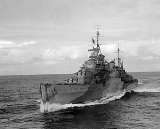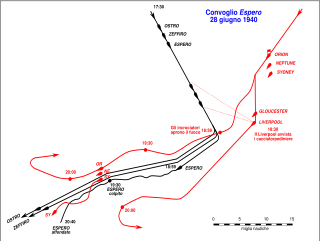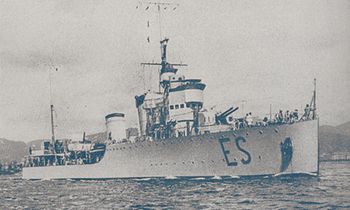
Battle of the Espero Convoy
Encyclopedia
The Battle of the Espero Convoy was the first Second World War
surface engagement between Italian and Allied
warships. It took place southwest of Crete
on 28 June 1940, after a force of seven cruiser
s and 16 destroyer
s, preparing to escort three Allied convoy
s to Alexandria
, were informed of the presence of an Italian flotilla of three destroyers. The Italian warships were bound from Taranto
to Tobruk
, carrying an anti-tank army unit to north Africa.
and France
. The Italian High Command (Comando Supremo) expected a British Army
advance into Cyrenaica
led by armoured forces, and decided that an anti-tank unit should be moved to Tobruk as soon as possible. The unit comprised 10 anti-tank guns, 120 ST (108.9 t) of ammunition, and 162 soldiers.
destroyer
s to transport the anti-tank unit, for their high speed (36 kn (43.8 mph; 70.6 km/h)) and loading capacity. The three chosen were Espero (flagship
), Zeffiro and Ostro. The Italian flotilla was commanded by Capitano di Vascello Enrico Baroni.
At the same time, three Allied convoys—two from Malta
and another from Greece
—were to be brought to Alexandria, covered by seven cruisers (two light cruiser
s— and —and five of the 7th Cruiser Squadron: (flagship), , , and ) and 16 destroyers. The British warships were commanded by Vice-Admiral John Tovey
. The Allied operation was supported by Short Sunderland
flying boat
s from Alexandria and Malta.
 The Italian destroyers were found at noon by two Sunderlands some 50 mi (43.4 nmi; 80.5 km) west of Zante island. They were within striking range of Tovey’s 7th Squadron, so he ordered them to intercept the Italians in two divisions.
The Italian destroyers were found at noon by two Sunderlands some 50 mi (43.4 nmi; 80.5 km) west of Zante island. They were within striking range of Tovey’s 7th Squadron, so he ordered them to intercept the Italians in two divisions.
The first 6 in (152.4 mm) salvoes from the Allied cruisers were fired at 18:30 at the surprised Italian flotilla at a range of 18000 yd (16,459.2 m). Baroni realised that—despite the best speed of his ships—they were hopelessly outgunned.The destroyers should have been able to outrun the cruisers, but one source states that Espero had mechanical problems that limited it to 25 knots. He therefore decided to sacrifice Espero in order to enable the other two to escape: Espero laid smokescreens and conducted evasive manoeuvres. Zeffiro and Ostro headed safely to the southwest at full speed.
Despite heavy firing, Espero was not hit until 19:20, when the range had closed to 14000 yd (12,801.6 m). By this time, Tovey had given up the chase of the other two destroyers. The 7th Squadron expended about 5,000 shells before Espero was sunk, after 130 minutes of fierce fighting.
A single Italian 4.7 in (119.4 mm) shell hit HMS Liverpool, but caused little damage. The battle exacerbated a shortage of ammunition at Alexandria so that the planned Malta convoys were suspended for two weeks. HMAS Sydney rescued 47 men from the Italian destroyer, and six others were later found alive by an Italian submarine almost 20 days later. Captain Baroni died aboard his ship, and was posthumously awarded the Medaglia d´oro al valor militare
. Zeffiro and Ostro both reached Benghazi
the next day and arrived at Tobruk shortly after. Two-thirds of the convoy had been saved.
 There were lessons learned by both sides after this battle. For the Allies, the battle showed that a daylight naval action at long range was unlikely to be decisive when the enemy units outmatched one's own speed. For the Italians, this was a grim lesson about the importance of well-coordinated air surveillance. Had Italian aircraft spotted the Allied cruisers before they came within range, all three destroyers would have escaped unscathed.
There were lessons learned by both sides after this battle. For the Allies, the battle showed that a daylight naval action at long range was unlikely to be decisive when the enemy units outmatched one's own speed. For the Italians, this was a grim lesson about the importance of well-coordinated air surveillance. Had Italian aircraft spotted the Allied cruisers before they came within range, all three destroyers would have escaped unscathed.
World War II
World War II, or the Second World War , was a global conflict lasting from 1939 to 1945, involving most of the world's nations—including all of the great powers—eventually forming two opposing military alliances: the Allies and the Axis...
surface engagement between Italian and Allied
Allies of World War II
The Allies of World War II were the countries that opposed the Axis powers during the Second World War . Former Axis states contributing to the Allied victory are not considered Allied states...
warships. It took place southwest of Crete
Crete
Crete is the largest and most populous of the Greek islands, the fifth largest island in the Mediterranean Sea, and one of the thirteen administrative regions of Greece. It forms a significant part of the economy and cultural heritage of Greece while retaining its own local cultural traits...
on 28 June 1940, after a force of seven cruiser
Cruiser
A cruiser is a type of warship. The term has been in use for several hundreds of years, and has had different meanings throughout this period...
s and 16 destroyer
Destroyer
In naval terminology, a destroyer is a fast and maneuverable yet long-endurance warship intended to escort larger vessels in a fleet, convoy or battle group and defend them against smaller, powerful, short-range attackers. Destroyers, originally called torpedo-boat destroyers in 1892, evolved from...
s, preparing to escort three Allied convoy
Convoy
A convoy is a group of vehicles, typically motor vehicles or ships, traveling together for mutual support and protection. Often, a convoy is organized with armed defensive support, though it may also be used in a non-military sense, for example when driving through remote areas.-Age of Sail:Naval...
s to Alexandria
Alexandria
Alexandria is the second-largest city of Egypt, with a population of 4.1 million, extending about along the coast of the Mediterranean Sea in the north central part of the country; it is also the largest city lying directly on the Mediterranean coast. It is Egypt's largest seaport, serving...
, were informed of the presence of an Italian flotilla of three destroyers. The Italian warships were bound from Taranto
Taranto
Taranto is a coastal city in Apulia, Southern Italy. It is the capital of the Province of Taranto and is an important commercial port as well as the main Italian naval base....
to Tobruk
Tobruk
Tobruk or Tubruq is a city, seaport, and peninsula on Libya's eastern Mediterranean coast, near the border with Egypt. It is the capital of the Butnan District and has a population of 120,000 ....
, carrying an anti-tank army unit to north Africa.
Background
On 10 June 1940, Italy declared war on BritainUnited Kingdom
The United Kingdom of Great Britain and Northern IrelandIn the United Kingdom and Dependencies, other languages have been officially recognised as legitimate autochthonous languages under the European Charter for Regional or Minority Languages...
and France
French Third Republic
The French Third Republic was the republican government of France from 1870, when the Second French Empire collapsed due to the French defeat in the Franco-Prussian War, to 1940, when France was overrun by Nazi Germany during World War II, resulting in the German and Italian occupations of France...
. The Italian High Command (Comando Supremo) expected a British Army
British Army
The British Army is the land warfare branch of Her Majesty's Armed Forces in the United Kingdom. It came into being with the unification of the Kingdom of England and Scotland into the Kingdom of Great Britain in 1707. The new British Army incorporated Regiments that had already existed in England...
advance into Cyrenaica
Cyrenaica
Cyrenaica is the eastern coastal region of Libya.Also known as Pentapolis in antiquity, it was part of the Creta et Cyrenaica province during the Roman period, later divided in Libia Pentapolis and Libia Sicca...
led by armoured forces, and decided that an anti-tank unit should be moved to Tobruk as soon as possible. The unit comprised 10 anti-tank guns, 120 ST (108.9 t) of ammunition, and 162 soldiers.
Prelude
The Italians chose three Turbine-classTurbine class destroyer
Turbine class was a class of destroyers built for the Italian Regia Marina in the late 1920s. They were essentially larger versions of the earlier .- Turbine class ships :*Aquilone -...
destroyer
Destroyer
In naval terminology, a destroyer is a fast and maneuverable yet long-endurance warship intended to escort larger vessels in a fleet, convoy or battle group and defend them against smaller, powerful, short-range attackers. Destroyers, originally called torpedo-boat destroyers in 1892, evolved from...
s to transport the anti-tank unit, for their high speed (36 kn (43.8 mph; 70.6 km/h)) and loading capacity. The three chosen were Espero (flagship
Flagship
A flagship is a vessel used by the commanding officer of a group of naval ships, reflecting the custom of its commander, characteristically a flag officer, flying a distinguishing flag...
), Zeffiro and Ostro. The Italian flotilla was commanded by Capitano di Vascello Enrico Baroni.
At the same time, three Allied convoys—two from Malta
Malta
Malta , officially known as the Republic of Malta , is a Southern European country consisting of an archipelago situated in the centre of the Mediterranean, south of Sicily, east of Tunisia and north of Libya, with Gibraltar to the west and Alexandria to the east.Malta covers just over in...
and another from Greece
Greece
Greece , officially the Hellenic Republic , and historically Hellas or the Republic of Greece in English, is a country in southeastern Europe....
—were to be brought to Alexandria, covered by seven cruisers (two light cruiser
Light cruiser
A light cruiser is a type of small- or medium-sized warship. The term is a shortening of the phrase "light armored cruiser", describing a small ship that carried armor in the same way as an armored cruiser: a protective belt and deck...
s— and —and five of the 7th Cruiser Squadron: (flagship), , , and ) and 16 destroyers. The British warships were commanded by Vice-Admiral John Tovey
John Tovey, 1st Baron Tovey
Admiral of the Fleet John Cronyn "Jack" Tovey, 1st Baron Tovey GCB, KBE, DSO, DCL was a Royal Navy admiral who served in both World Wars. He signed himself as "Jack", not "John". Tovey joined the Royal Navy before World War I, and commanded destroyers in that war. He rose, with several senior...
. The Allied operation was supported by Short Sunderland
Short Sunderland
The Short S.25 Sunderland was a British flying boat patrol bomber developed for the Royal Air Force by Short Brothers. It took its service name from the town and port of Sunderland in northeast England....
flying boat
Flying boat
A flying boat is a fixed-winged seaplane with a hull, allowing it to land on water. It differs from a float plane as it uses a purpose-designed fuselage which can float, granting the aircraft buoyancy. Flying boats may be stabilized by under-wing floats or by wing-like projections from the fuselage...
s from Alexandria and Malta.
Battle

The first 6 in (152.4 mm) salvoes from the Allied cruisers were fired at 18:30 at the surprised Italian flotilla at a range of 18000 yd (16,459.2 m). Baroni realised that—despite the best speed of his ships—they were hopelessly outgunned.The destroyers should have been able to outrun the cruisers, but one source states that Espero had mechanical problems that limited it to 25 knots. He therefore decided to sacrifice Espero in order to enable the other two to escape: Espero laid smokescreens and conducted evasive manoeuvres. Zeffiro and Ostro headed safely to the southwest at full speed.
Despite heavy firing, Espero was not hit until 19:20, when the range had closed to 14000 yd (12,801.6 m). By this time, Tovey had given up the chase of the other two destroyers. The 7th Squadron expended about 5,000 shells before Espero was sunk, after 130 minutes of fierce fighting.
A single Italian 4.7 in (119.4 mm) shell hit HMS Liverpool, but caused little damage. The battle exacerbated a shortage of ammunition at Alexandria so that the planned Malta convoys were suspended for two weeks. HMAS Sydney rescued 47 men from the Italian destroyer, and six others were later found alive by an Italian submarine almost 20 days later. Captain Baroni died aboard his ship, and was posthumously awarded the Medaglia d´oro al valor militare
Gold Medal of Military Valor
The Gold Medal of Military Valor is an Italian medal established on 21 May 1793 by King Victor Amadeus III of Sardinia "....per bassi ufficiali e soldati che avevano fatto azioni di segnalato valore in guerra" .The face of the medal displayed the profile of the king, and on its reverse was a flag...
. Zeffiro and Ostro both reached Benghazi
Benghazi
Benghazi is the second largest city in Libya, the main city of the Cyrenaica region , and the former provisional capital of the National Transitional Council. The wider metropolitan area is also a district of Libya...
the next day and arrived at Tobruk shortly after. Two-thirds of the convoy had been saved.
Aftermath


